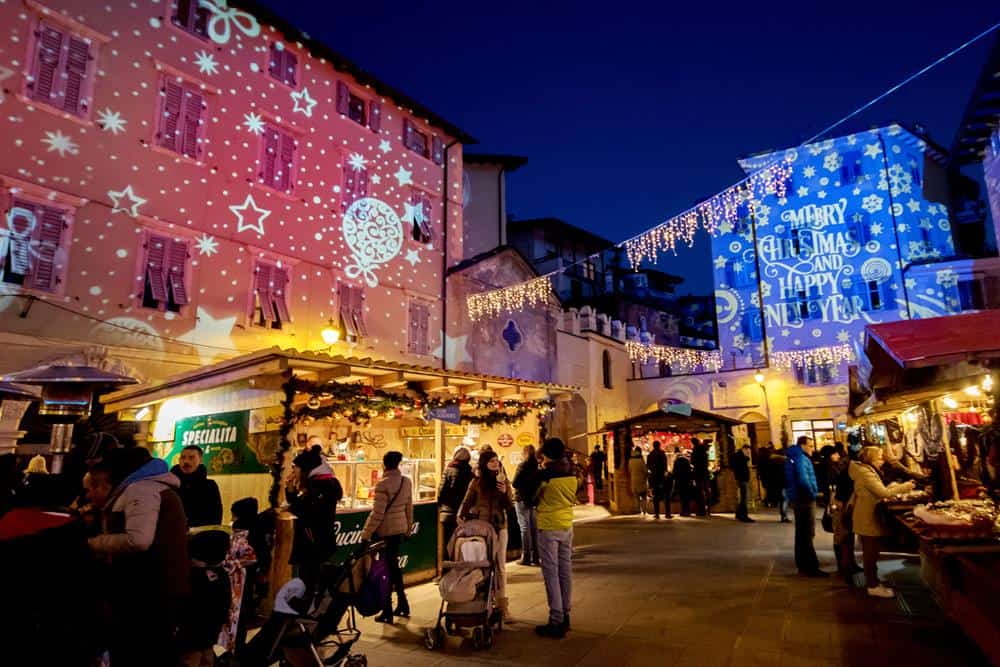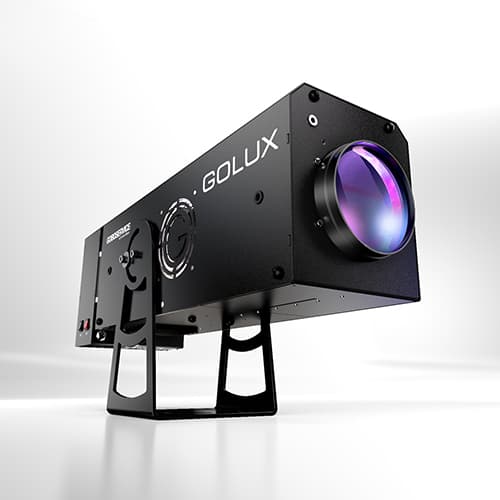Goboservice has always pursued the philosophy of maximum energy efficiency and has paid particular attention to the design of all its projectors. To the Led series, the latest born in the Sunland Optics house, he wanted to dedicate a long phase of study and design to offer a product with the best features in terms of luminous efficiency, reliability, image quality. The Goled is for example a small 27Watt COB LED projector, which manages to develop 625 lux at 4 meters away with 24 ° optics.

But what’s behind Christmas projections of great scenic effect? A few tricks and the right gobo-projectors. Those of Goboservice of course!
Let’s see how Christmas projections of great scenic effect can be obtained that meet different expectations with the use of gobo projectors.
1. Define the surface to be illuminated
The first thing to clarify is the size of the surface to be illuminated: both in height and in length. But we don’t stop there. Gobo projection can also affect multiple sides of a building, or multiple buildings. Of course…. If you ask us to illuminate the mythical octagonal Castel del Monte, let’s talk about it in time …
Suitable surfaces and surfaces unsuitable for projection
All masonry or wooden surfaces are suitable for the projection of gobos, no matter the color. But the yield is better on light and regular surfaces.
The ones that are not good are mirrored or high-reflectivity surfaces unless you want to flash your potential guests. But if that’s your intent, you don’t need Christmas gobos.
Surfaces with windows and glazing.
Light passes through the glass. Since the origin of the world. For this reason, the image projected by the gobo will not be visible on a glass or window. But don’t give up. Closed shutters or a good curtain placed behind the transparent surface are enough and that’s it. You can also light up the Crystal Palace in Madrid. Alternatively, there are adhesive films on the market to be applied to the glass that reduce its transparency and thus allow projection.
2. Projection Distance.
It is the distance between the projector gobo and the surface to be illuminated. It is not always possible to position the projector in the most suitable point and often the positioning is constrained by various factors such as the space available or the position of the poles on which the projector can be installed.
We take into account the extreme principles: the size of the image is directly proportional to the projection distance. The farther the projector is, the larger the image I get. On the other hand, it must be borne in mind that the larger the image, the less concentrated the light will be. You can’t have it all. But you can have the best: For most Christmas projection installations, the optimal distance is between 20 and 100 meters. Below 10 meters, the number of projectors needed to cover the surface will be very high.
Over 100 meters, special optics (telephoto lenses) are required. And we also have the ones we see in the next point.
3. Choice of optics
Attention: the size of the projected image is not only related to the projection distance but also to the size of the gobo (ID) and the projector lens.
A lens is characterized by its focal length expressed in mm. The shorter the length, the more the lens “opens” the beam. We can distinguish between:
wide-angle lenses with focal length up to 45mm
normal optics with length between 50 and 70 mm
telephoto lenses with focal length between 70 and 1000mm (I wrote to you that we have it …)
zoom (with variable focal length).
For example, a projector at 20 meters with 100mm optics creates an image of 9 meters in diameter
By changing only the optics, with the same ID, and using a wide-angle lens for example 56mm, you get an image of 16 meters in diameter. Inside you can reproduce the whole Divine Comedy with paraphrases and exegesis (I don’t know, however, how much it will serve you for a Christmas screening).
Focal length of the lens and ID of the gobo contribute to determining the aperture angle.


4. Brightness of the projector
The final brightness of a projection system, as the human eye perceives it, will be the result of the combination of several factors.
In particular, the brightness decreases as it grows:
the size of the projected image,
the ambient brightness,
the reflectivity value of the projection surface.
It is also important not to confuse between lumens from the lamp and lumens emitted by the headlamps, just as, daring a car comparison, the power of the engine does not express the maximum speed of the car. A very powerful engine will not be able to generate high speeds if the vehicle is not designed according to aerodynamic criteria or if an inappropriate ratio is used. Clear?
Ultimately, what you need to check to be sure you have the right amount of light is not the power of the lamp (400W, 1000W, 1500W, 2500W) but… the illuminance.
This parameter can be easily measured using a Luxmeter and is expressed in “lux”.
Keep calm. The manufacturers of projectors provide photometric diagrams that show the lux measured at various projection distances. And this is certainly one of the fundamental parameters to keep in mind when choosing the projector. For example, in order to carry out a Christmas-type projection, a projector must be able to emit at least double the “ambient” lux measured on the surface before the projector is switched on. Do we want to create suggestive effects or not?
5. Photometric diagrams
Photometric diagrams allow you to measure the impact of a luminaire on the surface where the projection will be made. As can be seen from the graph, after placing a gobo-projector with a power of 3500 lumens, the image shown on a 52.8 mm gobo will have a brightness of 4,840 lux at 2 meters and 190 lux at ten meters. This derives from the fact that by increasing the amplitude of the luminous flux in the projection cone, the intensity of light is dispersed over a larger surface. It is a law of nature that you have to live with.

The choice of the projector to use for our Christmas projections basically depends on a few variables:
whether the projection is to be made indoors or outside a building;
if the surface to be illuminated and characterized is more or less distant from the projection point;
how wide it is.
Goboservice offers 6 possible alternatives of professional outdoor projectors for Christmas projections with effects of falling snow or stars
Golive 400 is a powerful projector designed for medium distances (up to 60 m) that can be used for architectural and environmental projections outdoors, allowing the projection of clear images in the presence of light glare without losing image quality.
Golux 600WE Ideal when you have a small projection distance (up to 30 meters) and a large surface to illuminate
Golux 1000ZE. This last product, extremely performing thanks to the high performance of the brand new Philips MSR Gold 1000 MiniFastFit lamp, ensures high light output over long distances (up to one kilometer) while keeping energy consumption low. Another strong point of this machine that makes it extremely versatile is the equipment of a zoom normally used with “moving heads” with a variable aperture from 8 ° to 40 °.
Golux 1000WE and Golux 1000ME. These are the fixed optic versions of the Golux 1000.
Divum 30KE is the new 30,000 lumen LED projector, with IP54 protection degree
At this point we have given you the basic information to decide what to buy. Our references can be found on the home page. Happy holidays with Goboservice !!!!






